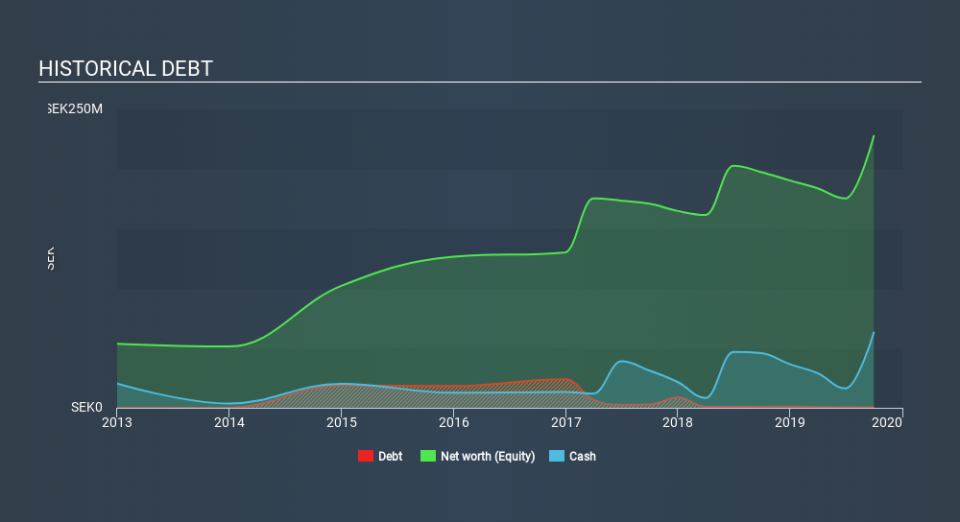We're Keeping An Eye On Intervacc's (STO:IVACC) Cash Burn Rate

There's no doubt that money can be made by owning shares of unprofitable businesses. Indeed, Intervacc (STO:IVACC) stock is up 154% in the last year, providing strong gains for shareholders. But while history lauds those rare successes, those that fail are often forgotten; who remembers Pets.com?
So notwithstanding the buoyant share price, we think it's well worth asking whether Intervacc's cash burn is too risky In this article, we define cash burn as its annual (negative) free cash flow, which is the amount of money a company spends each year to fund its growth. The first step is to compare its cash burn with its cash reserves, to give us its 'cash runway'.
View our latest analysis for Intervacc
How Long Is Intervacc's Cash Runway?
A cash runway is defined as the length of time it would take a company to run out of money if it kept spending at its current rate of cash burn. As at September 2019, Intervacc had cash of kr63m and such minimal debt that we can ignore it for the purposes of this analysis. Importantly, its cash burn was kr39m over the trailing twelve months. Therefore, from September 2019 it had roughly 20 months of cash runway. That's not too bad, but it's fair to say the end of the cash runway is in sight, unless cash burn reduces drastically. The image below shows how its cash balance has been changing over the last few years.
How Well Is Intervacc Growing?
Some investors might find it troubling that Intervacc is actually increasing its cash burn, which is up 19% in the last year. The fact that operating revenue was down 56% only gives us further disquiet. Considering both these metrics, we're a little concerned about how the company is developing. While the past is always worth studying, it is the future that matters most of all. For that reason, it makes a lot of sense to take a look at our analyst forecasts for the company.
Can Intervacc Raise More Cash Easily?
Since Intervacc can't yet boast improving growth metrics, the market will likely be considering how it can raise more cash if need be. Issuing new shares, or taking on debt, are the most common ways for a listed company to raise more money for its business. One of the main advantages held by publicly listed companies is that they can sell shares to investors to raise cash to fund growth. By comparing a company's annual cash burn to its total market capitalisation, we can estimate roughly how many shares it would have to issue in order to run the company for another year (at the same burn rate).
Intervacc has a market capitalisation of kr814m and burnt through kr39m last year, which is 4.8% of the company's market value. That's a low proportion, so we figure the company would be able to raise more cash to fund growth, with a little dilution, or even to simply borrow some money.
So, Should We Worry About Intervacc's Cash Burn?
Even though its falling revenue makes us a little nervous, we are compelled to mention that we thought Intervacc's cash burn relative to its market cap was relatively promising. Cash burning companies are always on the riskier side of things, but after considering all of the factors discussed in this short piece, we're not too worried about its rate of cash burn. When you don't have traditional metrics like earnings per share and free cash flow to value a company, many are extra motivated to consider qualitative factors such as whether insiders are buying or selling shares. Please Note: Intervacc insiders have been trading shares, according to our data. Click here to check whether insiders have been buying or selling.
If you would prefer to check out another company with better fundamentals, then do not miss this free list of interesting companies, that have HIGH return on equity and low debt or this list of stocks which are all forecast to grow.
If you spot an error that warrants correction, please contact the editor at editorial-team@simplywallst.com. This article by Simply Wall St is general in nature. It does not constitute a recommendation to buy or sell any stock, and does not take account of your objectives, or your financial situation. Simply Wall St has no position in the stocks mentioned.
We aim to bring you long-term focused research analysis driven by fundamental data. Note that our analysis may not factor in the latest price-sensitive company announcements or qualitative material. Thank you for reading.

